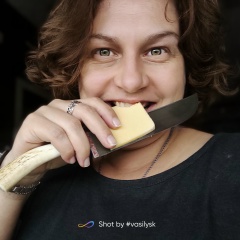Цвет в живописи.
•••
Давно я планировала написать данную статью, но никак не могла к ней подступиться. Информации о цвете очень много и не знаешь, о чем именно писать. А так как сейчас я интенсивно разбираюсь в теме живописи, то собрала своё мужество в кулак и взялась.
•••
Введение
•••
Цвет происходит от света. О свете и образовании лучей разной длины я уже писала. Это зависящие друг от друга явления. В живописи не существует чёрного и белого цветов. Белый цвет это все цвета сразу, а чёрный - это отсутствие света и соответственно цвета в принципе. Белый - отражает свет, чёрный - поглощает.
•••
Локальный цвет предмета, распределение цвета в среде.
•••
У любого предмета существует локальный цвет - свойственный только ему. Например, лимон желтый. Но! Большая ошибка в живописи писать лимон исключительно желтой краской, а тень делать серой или чёрной. Так не бывает. Предмет находится в окружающей среде, он не вырван из неё, он часть среды и писать его надо целостно со средой.
Что это значит? То, что лимон окружают другие предметы, что они тоже отражаются в среде и рассеивают свой цвет в пространстве. Например, если лимон лежит на красной поверхности, то в его локальном цвете будут присутствовать оттенки красного, а также оттенки неба, травы и всего того, что его окружает. При написании предмета необходимо детально исследовать натуру, хорошенько рассмотреть Ее и увидеть в локальном цвете другие оттенки. Мир красочен и не однороден! Что касается полутонов и теней-они не могут быть только серыми, в них должен быть локальный цвет и отраженные от других предметов цвета. Идеально, когда локальный цвет в тени отличается от цвета на свету по тональности и яркости. Изображение выглядит более реалистично, когда при распределении света по поверхности предмета соблюдаются тоновые отношения переходов, нет резких обрывов, альтов с контрабасами. Все должно быть гармонично-одно перетекает в другое. "Предмет - это зеркало световой среды. Написать предмет - значит в облике предмета отразить окружающую среду." Ревякин П.П.
•••
Продолжение следует...
•••
Картинка нарисована по импровизации, рисовала как чувствовала.
#портретназаказ #портрет #картинаназаказ #рисуйкаждыйдень #картина #учусьрисовать #вдохновение #путьхудожника
•••
Давно я планировала написать данную статью, но никак не могла к ней подступиться. Информации о цвете очень много и не знаешь, о чем именно писать. А так как сейчас я интенсивно разбираюсь в теме живописи, то собрала своё мужество в кулак и взялась.
•••
Введение
•••
Цвет происходит от света. О свете и образовании лучей разной длины я уже писала. Это зависящие друг от друга явления. В живописи не существует чёрного и белого цветов. Белый цвет это все цвета сразу, а чёрный - это отсутствие света и соответственно цвета в принципе. Белый - отражает свет, чёрный - поглощает.
•••
Локальный цвет предмета, распределение цвета в среде.
•••
У любого предмета существует локальный цвет - свойственный только ему. Например, лимон желтый. Но! Большая ошибка в живописи писать лимон исключительно желтой краской, а тень делать серой или чёрной. Так не бывает. Предмет находится в окружающей среде, он не вырван из неё, он часть среды и писать его надо целостно со средой.
Что это значит? То, что лимон окружают другие предметы, что они тоже отражаются в среде и рассеивают свой цвет в пространстве. Например, если лимон лежит на красной поверхности, то в его локальном цвете будут присутствовать оттенки красного, а также оттенки неба, травы и всего того, что его окружает. При написании предмета необходимо детально исследовать натуру, хорошенько рассмотреть Ее и увидеть в локальном цвете другие оттенки. Мир красочен и не однороден! Что касается полутонов и теней-они не могут быть только серыми, в них должен быть локальный цвет и отраженные от других предметов цвета. Идеально, когда локальный цвет в тени отличается от цвета на свету по тональности и яркости. Изображение выглядит более реалистично, когда при распределении света по поверхности предмета соблюдаются тоновые отношения переходов, нет резких обрывов, альтов с контрабасами. Все должно быть гармонично-одно перетекает в другое. "Предмет - это зеркало световой среды. Написать предмет - значит в облике предмета отразить окружающую среду." Ревякин П.П.
•••
Продолжение следует...
•••
Картинка нарисована по импровизации, рисовала как чувствовала.
#портретназаказ #портрет #картинаназаказ #рисуйкаждыйдень #картина #учусьрисовать #вдохновение #путьхудожника
Color in the painting.
•••
For a long time I had planned to write this article, but I could not approach it in any way. There is a lot of information about color and you don’t know what exactly to write about. And since now I am intensively versed in the topic of painting, I gathered my courage into a fist and took it.
•••
Introduction
•••
Color comes from light. I already wrote about the light and the formation of rays of different lengths. These are mutually dependent phenomena. In painting, there is no black and white colors. White color is all colors at once, and black is the absence of light and, accordingly, color in principle. White - reflects light, black - absorbs.
•••
Local color of the item, color distribution in the medium.
•••
Any object has a local color - peculiar only to it. For example, lemon is yellow. But! It’s a big mistake in painting to write a lemon with exclusively yellow paint, and make the shadow gray or black. This does not happen. The subject is in the environment, it is not torn from it, it is part of the environment and it must be written holistically with the environment.
What does it mean? The fact that other objects surround the lemon, that they, too, are reflected in the medium and disperse their color in space. For example, if a lemon lies on a red surface, then in its local color there will be shades of red, as well as shades of sky, grass and everything that surrounds it. When writing the subject, it is necessary to examine the nature in detail, carefully examine it and see other shades in the local color. The world is colorful and not homogeneous! As for the midtones and shadows, they cannot only be gray, they should have a local color and the colors reflected from other objects. Ideally, when the local color in the shade differs from the color in the light in tone and brightness. The image looks more realistic when, in the distribution of light on the surface of the object, tonal transition relations are observed, there are no sharp breaks, alts with double basses. Everything should be harmonious, one flows into the other. "An object is a mirror of a light environment. To write an object is to reflect the environment in the appearance of the object." Revyakin P.P.
•••
To be continued...
•••
The picture was drawn by improvisation, painted as I felt.
# portrait order # portrait # picture order # draw every day # picture # study draw # inspiration # artist’s path
•••
For a long time I had planned to write this article, but I could not approach it in any way. There is a lot of information about color and you don’t know what exactly to write about. And since now I am intensively versed in the topic of painting, I gathered my courage into a fist and took it.
•••
Introduction
•••
Color comes from light. I already wrote about the light and the formation of rays of different lengths. These are mutually dependent phenomena. In painting, there is no black and white colors. White color is all colors at once, and black is the absence of light and, accordingly, color in principle. White - reflects light, black - absorbs.
•••
Local color of the item, color distribution in the medium.
•••
Any object has a local color - peculiar only to it. For example, lemon is yellow. But! It’s a big mistake in painting to write a lemon with exclusively yellow paint, and make the shadow gray or black. This does not happen. The subject is in the environment, it is not torn from it, it is part of the environment and it must be written holistically with the environment.
What does it mean? The fact that other objects surround the lemon, that they, too, are reflected in the medium and disperse their color in space. For example, if a lemon lies on a red surface, then in its local color there will be shades of red, as well as shades of sky, grass and everything that surrounds it. When writing the subject, it is necessary to examine the nature in detail, carefully examine it and see other shades in the local color. The world is colorful and not homogeneous! As for the midtones and shadows, they cannot only be gray, they should have a local color and the colors reflected from other objects. Ideally, when the local color in the shade differs from the color in the light in tone and brightness. The image looks more realistic when, in the distribution of light on the surface of the object, tonal transition relations are observed, there are no sharp breaks, alts with double basses. Everything should be harmonious, one flows into the other. "An object is a mirror of a light environment. To write an object is to reflect the environment in the appearance of the object." Revyakin P.P.
•••
To be continued...
•••
The picture was drawn by improvisation, painted as I felt.
# portrait order # portrait # picture order # draw every day # picture # study draw # inspiration # artist’s path

У записи 2 лайков,
0 репостов,
91 просмотров.
0 репостов,
91 просмотров.
Эту запись оставил(а) на своей стене Анна Денеко























